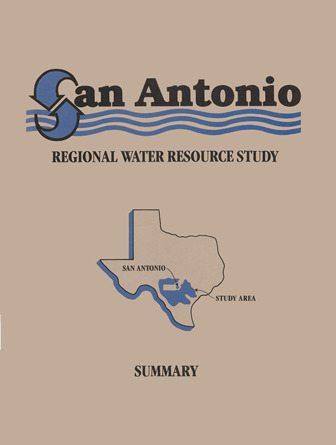San Antonio Regional Water Resource Study-Summary

| Author | Edwards Underground Water District and City of San Antonio |
| Year | 1980 |
| Description | Non-technical discussion of various alternatives for ensuring water supply for the greater San Antonio region through 2040, a 60-year horizon. Note: This report is included for its historical value and may have been superseded by more recent studies. |
| Publisher | Edwards Underground Water District, City of San Antonio |
| Location | Uvalde County, Medina County, Bexar County, Comal County, Hays County |
| Cover | View Download |
| File | View Download |
| Summary |
|
Note: This report is included for its historical value and may have been replaced by more recent studies. Continued long-term availability of water from the Edwards Aquifer requires both a technical knowledge of the quantity it can supply, and an understanding of the inseparability of quantity and the quality of the water in the Aquifer. Protection of quality is of primary importance to the future of the Region. Present efforts directed toward water quality protection must be continued and must be intensified if necessary. The Regional Study and this implementation effort have as their focus and intent the achievement of a Regional consensus on those measures and actions required to provide the Region’s water users with an adequate long-term water supply of high quality. To this end, the study set out to provide a report that will: • Enable reasonable people to make responsible decisions concerning public and private investments in the water resources of the Region, • Insure that those decisions are consistent with regional economic development and environmental integrity and • Inspire long-term confidence in these decisions. The Regional Study has provided a framework to solve these regional problems: • Provide an adequate and reliable water supply for a population expected to grow from 1.1 million people in 1980 to 3.2 million people in 2040. • Meet short and long term water demands – even when droughts occur. • Protect water quality in the Edwards and the stream systems – both from direct pollution and from movement of poor quality water into the Aquifer during periods of prolonged overpumping. • Share water resources and costs for their development and use fairly among all purposes and parts of the Region. • Recognize primary uses of water as they differ from East to West in the Region and permit choices of solutions that are tailored to fit needs and preferences of each area. • Avoid crisis decisions – whether forced by droughts, floods, or recessions. • Retain control of costs and choices of resource allocation at the most appropriate local level. • Maintain flexibility over time to respond properly to changing conditions as the people in the Region choose. • Avoid committing either money or resources before they are needed for recognized and agreed purposes. • Retain management control of decisions at the most local level of government appropriate. |
Search for Documents
Advance Search
Explore EAA's Scientific Reports
- All Reports
- Overview Studies
- Modeling
- Hydrology and Hydrogeology
- History
- Groundwater Recharge, Recharge Zone
- Groundwater Movement
- Geomorphology and Caves
- Weather Modification
- Geology
- Water Use and Conservation
- Geochemistry
- Water Resources Planning and Management
- Floods and Drought
- Water Quality
- Climatology
- Surface Water / Groundwater Relationship
- Biology
- Springs, Groundwater Discharge
- Archaeology
- RZ Protection
- Aquifer Levels
- Remote Sensing
- Precipitation
